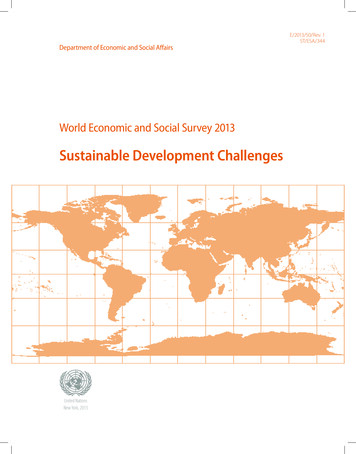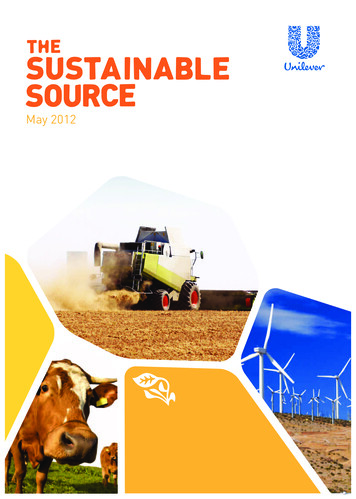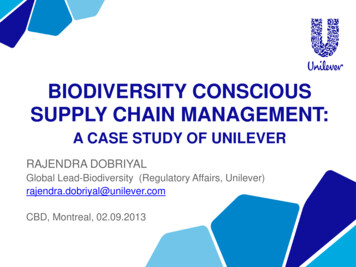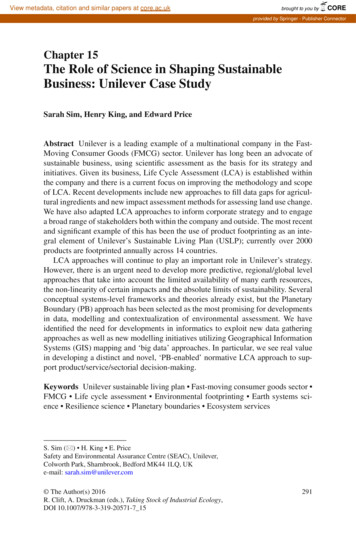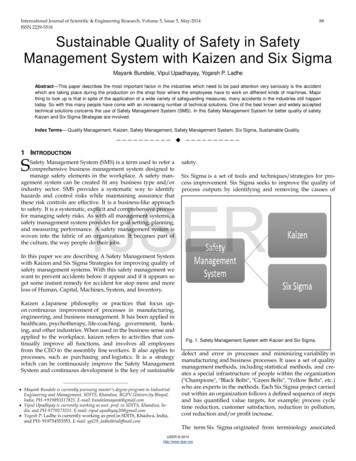
Transcription
International Journal of Scientific & Engineering Research, Volume 5, Issue 5, May-2014ISSN 2229-551888Sustainable Quality of Safety in SafetyManagement System with Kaizen and Six SigmaMayank Bundele, Vipul Upadhayay, Yogesh P. LadheAbstract—This paper describes the most important factor in the industries which need to be paid attention very seriously is the accidentwhich are taking place during the production on the shop floor where the employees have to work on different kinds of machines. Majorthing to look up is that in spite of the application of a wide variety of safeguarding measures, many accidents in the industries still happentoday. So with this many people have come with an increasing number of technical solutions. One of the best known and widely acceptedtechnical solutions concerns the use of Safety Management System (SMS). In this Safety Management System for better quality of safetyKaizen and Six Sigma Strategies are involved.Index Terms— Quality Management, Kaizen, Safety Management, Safety Management System, Six Sigma, Sustainable Quality.—————————— ——————————1 INTRODUCTIONSSafety Management System (SMS) is a term used to refer acomprehensive business management system designed tomanage safety elements in the workplace. A safety management system can be created fit any business type and/orindustry sector. SMS provides a systematic way to identifyhazards and control risks while maintaining assurance thatthese risk controls are effective. It is a business-like approachto safety. It is a systematic, explicit and comprehensive processfor managing safety risks. As with all management systems, asafety management system provides for goal setting, planning,and measuring performance. A safety management system iswoven into the fabric of an organization. It becomes part ofthe culture, the way people do their jobs.safety.Six Sigma is a set of tools and techniques/strategies for process improvement. Six Sigma seeks to improve the quality ofprocess outputs by identifying and removing the causes ofIJSERIn this paper we are describing A Safety Management Systemwith Kaizen and Six Sigma Strategies for improving quality ofsafety management systems. With this safety management wewant to prevent accidents before it appear and if it appears soget some instant remedy for accident for stop more and moreloss of Human, Capital, Machines, System, and Inventory.Kaizen a Japanese philosophy or practices that focus upon continuous improvement of processes in manufacturing,engineering, and business management. It has been applied inhealthcare, psychotherapy, life-coaching, government, banking, and other industries. When used in the business sense andapplied to the workplace, kaizen refers to activities that continually improve all functions, and involves all employeesfrom the CEO to the assembly line workers. It also applies toprocesses, such as purchasing and logistics. It is a strategywhich can be continuously improve the Safety ManagementSystem and continuous development is the key of ——— Mayank Bundele is currently pursuing master’s degree program in IndustrialEngineering and Management, SDITS, Khandwa, RGPV Univercity Bhopal,India, PH- 919893317825. E-mail: bundelemayank@gmail.com Vipul Upadhyay is currently working as asst. prof. in SDITS, Khandwa, India, and PH-9770573251. E-mail: vipul.upadhyay20@gmail.com Yogesh P. Ladhe is currently working as prof.in SDITS, Khadwa, India,and PH- 919754553553. E-mail: ypl29 ladhe@rediffmail.comFig. 1. Safety Management System with Kaizen and Six Sigma.defect and error in processes and minimizing variability inmanufacturing and business processes. It uses a set of qualitymanagement methods, including statistical methods, and creates a special infrastructure of people within the organization("Champions", "Black Belts", "Green Belts", "Yellow Belts", etc.)who are experts in the methods. Each Six Sigma project carriedout within an organization follows a defined sequence of stepsand has quantified value targets, for example; process cycletime reduction, customer satisfaction, reduction in pollution,cost reduction and/or profit increase.The term Six Sigma originated from terminology associatedIJSER 2014http://www.ijser.org
International Journal of Scientific & Engineering Research, Volume 5, Issue 5, May-2014ISSN 2229-5518with manufacturing, specifically terms associated with statistical modelling of manufacturing processes. The maturity of amanufacturing process can be described by a sigma ratingindicating its yield or the percentage of defect-free products itcreates. A six sigma process is one in which 99.99966% of theproducts manufactured are statistically expected to be free ofdefects (3.4 defects per million).This Safety Management System can prevent the accidents andif accident will occur the system will take immediate action onit. This system can able to sustain safety in overall processes.System can reduces the losses during processes like Humanloss, Machine loss, Capital Loss, Inventory loss and Systemlosses. This system can find the sustainable safety in overallcycle.2 METHODOLOGYMajor thing to look up is that in spite of the application of awide variety of safeguarding measures, many accidents in theindustries still happen today. So with this many people havecome with an increasing number of technical solutions. Kaizendevelopment for continues improvement and Six Sigma forrectify errors in safety management. This overall cycle willtake place in three phases. 89standards. So Kaizen and Six Sigma Strategies can be apply onhuman Behavior and Technical development phases. Human Behaviour (Continuous Improvement) Knowledge Training Awake Aware Utilize Instruments Follow ISO Standards Follow Indian Standards Organisation Technological Development Safety of Inventory Safety of Machines Safety of Workers Safety of Capital3HUMAN BEHAVIOUR (PHASE 1)The phase 1 can be associated with Human Behaviour. In safety Human Behaviour can be changed by Kaizen. By the continuous improvement safety level in the industry will increaseday by day.IJSERSteps to change in Human BehaviourHuman BehaviorFollow ISO StandardsTechnical Development KnowledgeTrainingAwakeAwareUtilize InstrumentsGive the knowledge to worker of the particular operation hehas to work for. First of all the all the details of the operationand previous and predictable data should be explained in detailed to the workers and it’s on only one time process it mustbe continued time by time.Training is the most important factor for the worker. It willhelp them to how to assist a particular job with safety not onlythemselves but also for surrounding.Awaking the workers for their responsibilities with respect tocompany and their job. If they will understand as his work asa responsibility they will automatically work with efficientlyand with safety also.Fig. 2. Three phases of this Safety management System SafetyManagement System with Kaizen and Six Sigma.In all three phases the Kaizen and Six Sigma will implant onthe Human Behavior and Technical Development Phaseswhereas ISO standards cannot be change it will the same asInternational Organization for Standardization drive all theAwareness is the another factor in safety which change thedimension of the safety if a worker is aware between operations and he knows how to be alert in between duty hours soaccident will not take place in the industries.Worker need to be get knowledgeable and get trained forabout which instrument he is using if he don’t know about theinstrument which he is using can be permanent harm to himself, machine and instrument itself.IJSER 2014http://www.ijser.org
International Journal of Scientific & Engineering Research, Volume 5, Issue 5, May-2014ISSN 2229-5518This five steps can be improve by the Kaizen time bye timeand continuously improvement and training session can betransform the safety of the industries. 90ISO 9001:2008 - sets out the requirements of a qualitymanagement systemISO 9000:2005 - covers the basic concepts and languageISO 9004:2009 - focuses on how to make a qualitymanagement system more efficient and effectiveISO 19011:2011 - sets out guidance on internal and external audits of quality management systems.ISO 31000 - Risk management ISO 31000:2009, Risk management – Principles and guidelines, provides principles, framework and a processfor managing risk.IJSERFig. 3. Change in Human Behaviour using Kaizen Safety Management System with Kaizen and Six Sigma.Fig. 4. Safety Management System with ISO Standards4 FOLLOW ISO STANDARDS (PHASE 2)The International Organization for Standardization knownas ISO, is an international standard-setting body composed ofrepresentatives from various national standards organizations.ISO International Standards ensure that products and servicesare safe, reliable and of good quality. For business, they arestrategic tools that reduce costs by minimizing waste and errors and increasing productivity. They help companies to access new markets, level the playing field for developing countries and facilitate free and fair global trade. And it cannot bechanged whereas it will follow as it is given from the International Organization for Standardization.Some ISO Standards which company and works have to follow.ISO 9000 - Quality managementThere are many standards in the ISO 9000 family, including:5 TECHNICAL DEVELOPMENT (PHASE 3)Today Six Sigma quality community includes certification thatincorporates formal instruction, performance standards, andapplying a wide range of analytical problem-solving toolssuch as Pareto charts, process maps and fishbone diagrams. Itsmastery borrows martial arts vernacular (e.g., black belt,sensei) to define levels of understanding and performance. Inmuch the same way quality management made significantstrides during the 1980s, industrial safety is poised for its owntransformation.This provides an actionable approach to how a zero injuryculture can be driven by adopting the same tools and tactics ofproduct quality’s Six Sigma methodology.Applying Six Sigma thinking to safety has tremendous possibility and potential. Lean Six Sigma provides a framework forIJSER 2014http://www.ijser.org
International Journal of Scientific & Engineering Research, Volume 5, Issue 5, May-2014ISSN 2229-5518integrating safety into operations.In Six Sigma operations, safety is addressed in tactical as wellas strategic planning. The organizational systems that driveefficiency and quality are applied to the safety process. Safetygoals are aligned with business objectives, thereby creating alinkage between resource needs and allocation. Six Sigma isthe evolution of statistical quality improvement processes thathave been used extensively to improve manufacturing andother process-related industries.5.1DESIGN FOR SIX SIGMADesign for Six Sigma (DFSS) is a separate and emergingbusiness-process management methodology related to traditional Sigma. While the tools and order used in Six Sigma require a process to be in place and functioning, DFSS has theobjective of determining the needs of customers and the business, and driving those needs into the product solution so created. DFSS is relevant to the complex system/product synthesis phase, especially in the context of unprecedented systemdevelopment. It is process generation in contrast with processimprovement.91service process development, usually occurs after initial system or product design and development have been largelycompleted.The Six Sigma process calculates to 3.4 defects per million opportunities. Needless to say, that is near perfect execution of aprocess. Although not often used in the safety arena to fullpotential, Six Sigma tools can help produce significant andsustainable improvements in safety performance, injury reduction and associated pain.In this safety management system we are using the Six Sigmaas Safety Prevention strategy. We are using Six Sigma as aStrategy in Safety Management System which will identify theerror and rectify the error this strategy will try to safe processing and it will try to conduct the process as without anykind of failure. And if in any case accident will occur so system will try to stop very instantly.Technological Development Essentials Areas Safety of InventorySafety of MachinesSafety of workersSafety of SystemsIJSERFig. 5. Design for Six Sigma and its processesFig. 6. Technical Development in Safety Management SystemDMADV, define – measure – analyze – design – verify, issometimes synonymously referred to as DFSS. The traditionalDMAIC (define – measure – analyze – improve – Control) SixSigma process, as it is usually practiced, which is focused onevolutionary and continuous improvement manufacturing or5.2SAFTEY OF INVENTORYThe role of the inventory in the industries are going more andmore expensive if any kind of accident can damage the inven-IJSER 2014http://www.ijser.org
International Journal of Scientific & Engineering Research, Volume 5, Issue 5, May-2014ISSN 2229-5518tory so it will be a big loss and if in any case inventory are stolen it will be big loss for the company.To prevent this kind of incidents technology must be developwhich can be identify the person by using camera whichwearing company s Identity Card and if the person is notwearing the Identity Card so the technology active the alarmsystem. It can save inventory from being stolen.92lead to a sustainability of the systems this particular modelwill rectify the previous safety problems and it will upgrade anew safety model according to kaizen and the second phase ofthis strategy belongs to six sigma which will generate efficiency in production. This strategy can define new and the mostefficient model of sustainability in safety management systemwith kaizen and six sigma.ACKNOWLEDGMENT5.3SAFTEY OF MACHINESSafety of Machines is another area in which technological improvement must take place. Machines are most important assets of the company damaged in it and accidents of machinescan be transform company s profit into loss. Harvey machinery should be mounted with sensors to avoid accidents.Examples: Crane, Bulldozer, Roller, AVG, etc. So sensors areStop the machines when sensor will identify another personand another machine.Workers are backbone of any industry so safety of workersplay an important role in technological development. Withthis safety system accident will be stop before it occur in caseof accident machine must be shut off / down itself immediately after listening workers voice a Sound frequency system maybe developed. The group of sensors can identify the Shoutingfrequency of worker and stop that machine. REFERENCESK.G. Durga Prasad, K.Venkata Subbaiah, G.Padmavathi, “Application of SixSigma Methodology in an Engineering Educational Institution” Int. J. Emerg.Sci., 2(2), 222-237, June 2012.[2] Sandy L. Furterer, “Applying lean Six Sigma to reduce linen loss in an acutecare hospital”, International Journal of Engineering, Science and TechnologyVol. 3, No. 7, pp. 39-55, 2011.[3] Palanivel Subramaniyam, Karthick Srinivasan and Muni Prabaharan,” AnInnovative Lean Six Sigma Approach for Engineering Design” InternationalJournal of Innovation, Management and Technology, Vol. 2, No. 2, April 2011.[4] MICHAELANGELOD. TABONE, JAMESJ. CREGG, ERICJ. BECKMAN, ANDAMYE. LANDIS, “Sustainability Metrics: Life Cycle Assessment and Green Design in Polymers”, ENVIRONMENTAL SCIENCE & TECHNOLOGY Revised manuscript received August 27,2010. Accepted September 2, 2010.[5] F.N. van den Broek-Serlé, "Green Supply Chain Management, Marketing Tool or Revolution?”, Published on the occasion of the inaugural speech related to the lectureship Logistics & Sustainability,Breda, Zoetermeer, the Netherlands, January 2010.[6] Ernest Benedito, Albert Corominas,” Optimal manufacturing andremanufacturing capacities of system with reverse logistics and deterministic uniform demand” JIEM, 2010 – 3(1): 33-53 – Online ISSN:2013-0953 Print ISSN: 2013-8423. Robert Collier, “Bali Needs to Know– Can China go Green?” S.F. CHRON., Dec. 9, 2007.[7] Darshak A. Desai,” Improving customer delivery commitments the Six Sigmaway: case study of an Indian small scale industry”, Int. J. Six Sigma and Competitive Advantage, Vol. 2, No. 1, 2006.[8] Y. C. Ethan Lin,” Implementation of supply chain logistics processreengineering and e-business solutions for chain store business”, international Journal of Electronic Business Management, Vol. 4, No. 5,pp. 357-367 (2006).[9] Chen Song, Xiaohong Guan, Qianchuan Zhao, Qingshan Jia, “Planning Remanufacturing Systems by Constrained Ordinal Optimization Method with Feasibility Model”, Proceedings of the 44th IEEEConference on Decision and Control, and the European Control Conference 2005.[10] Kirsten Rosselot and David T. Allen,"Life-Cycle Concepts, ProductStewardship and Green Engineering”, Chemical Manufacturers Association, November 2000.[11] INDIRA NAIR, “Life Cycle Analysis and Green Design: A ContextIJSERA Sound Frequency System which can stop machineby recognize workers Voice Frequency.An Alternate Single button can be mounted whichcan shut off machine by single press.5.5SAFTEY OF SYSTEMSA Safety System must be develop in such a manner which areinvolved in Anti-fire system, Anti-Earth quake system, Electricity system to avoiding any kind of electric accidents, Fireaccidents and A system indicates you before Earth-Quake.Development Needed I would also like to thank Vipul Upadhayay, Yogesh p. Ladheand Subodh Singh for their support and knowledge to complete this work.[1]5.4SAFTEY OF WORKERSDevelopment NeededI would like to express my sincere gratitude to Rajneesh Kumar Rai for the opportunity to explore the field of Combinatorial Optimization. His encouragement, guidance, and supportwere invaluable in this work.Anti-Fire SystemAnti-Earthquake SystemElectricity SystemIn the field of safety, a regular and continuous improvement adepartment should be build up. The RND (research and development) program should be continuously held on.6 CONCLUSIONThis strategy belongs to sustainability of safety with integration of safety management system and the strategy kaizen willIJSER 2014http://www.ijser.org
International Journal of Scientific & Engineering Research, Volume 5, Issue 5, May-2014ISSN 2229-5518for Teaching Design, Environment, and Ethics", Journal of Engineering Education, October 1998.[12] Micheal M. Williamsen, “Safety Management Six Sigma Safety”, PROFESSIONAL SAFETY, www.asse.org JUNE 2005.J.S. Bridle, “Probabilistic Interpretation of Feedforward Classification Network Outputs, with Relationshipsto Statistical Pattern Recognition,” Neurocomputing—Algorithms, Architecturesand Applications, F. Fogelman-Soulie and J. Herault, eds., NATO ASI SeriesF68, Berlin: Springer-Verlag, pp. 227-236, 1989.IJSERIJSER 2014http://www.ijser.org93
the culture, the way people do their jobs. In this paper we are describing A Safety Management System with Kaizen and Six Sigma Strategies for improving quality of safety management systems. With this safety management we want to prevent accidents before it appear and if it appears so get some instant remedy for accident for stop more and more


